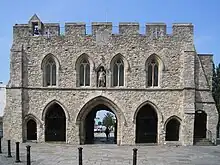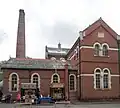Scheduled monuments in Hampshire
There are 735 scheduled monuments in the county of Hampshire, England.[1] These protected sites date from the Neolithic period and include barrows, artillery forts, ruined abbeys, castles, and Iron Age hill forts.[2] In the United Kingdom, the scheduling of monuments was first initiated to insure the preservation of "nationally important" archaeological sites or historic buildings. The protection given to scheduled monuments is given under the Ancient Monuments and Archaeological Areas Act 1979[3]
Notable scheduled monuments in Hampshire
| Image | Name | Location | Date | Notes |
|---|---|---|---|---|
 |
Bargate | 50°54′10″N 1°24′15″W | c 1180 AD | Norman gatehouse, part of the Southampton town walls. |
 |
Bishop's Waltham Palace | 50.95343°N 1.21409°W | 1135 AD | A moated Bishop's Palace ruin dating from the Norman Conquest.[4] |
 |
Buckland Rings | 50.77045°N 1.55464°W | Iron Age | The site of an Iron Age hill fort located in Lymington, Hampshire.[5] |
 |
Calshot Castle | 50°49′12″N 1°18′27″W | 1540 AD | This artillery fort was constructed by Henry VIII to defend Southampton.[6] |
 |
Flowerdown Barrows | 51°05′07″N 1°20′46″W | Bronze Age | The monumens consists of three Bronze Age burial mounds within a large cemetery, two bowl barrows and a well-preserved disc barrow.[7] |
 |
King John's Palace, Southampton | 50.89967°N 1.40665°W | Late 12th century | A ruined Norman merchant's house in Southampton. |
 |
Netley Abbey | 50.87865°N 1.35727°W | 1239 AD | The ruined abbey is the best surviving example of a Cistercian monastery in southern England.[8] |
 |
Portchester Castle | 50.836546°N 1.113034°W | Late 11th century | A medieval fortress built within the walls of the Roman Saxon Shore fort of Portus Adurni. It was also a prisoner of war camp during the Napoleonic Wars.[9] |
 |
Spitbank Fort | 50.77068°N 1.09895°W | 1867–1878 | A military sea fort located in the Solent, near Portsmouth.[10] |
 |
Twyford Waterworks | 51.02132°N 1.29915°W | 1898 | The monument consists of a late 19th-century pumping station and waterworks used to supply water to Winchester and Southampton.[11] |
References
- "Scheduled monuments in Hampshire". Historic England. Retrieved 3 January 2023.
- "Scheduled Ancient Monuments in the Historic County of Dorset". Ancient Monuments UK. Retrieved 28 January 2023.
- "Scheduled Monuments". Historic England. Retrieved 4 May 2023.
- "Bishop's Waltham Palace and associated fishponds". Historic England. Retrieved 8 May 2023.
- "Hillfort at Buckland Rings". Historic England. Retrieved 8 May 2023.
- "Calshot Castle". English Heritage. Retrieved 8 May 2023.
- "Flowerdown Barows, Littleton, Hampshire". Historic England. Retrieved 8 May 2023.
- "Netley Abbey". English Heritage. Retrieved 8 May 2023.
- "Portchester Castle". English Heritage. Retrieved 8 May 2023.
- "Spitbank Fort". Historic England. Retrieved 8 May 2023.
- "Pumping Station". Historic England. Retrieved 8 May 2023.
This article is issued from Wikipedia. The text is licensed under Creative Commons - Attribution - Sharealike. Additional terms may apply for the media files.